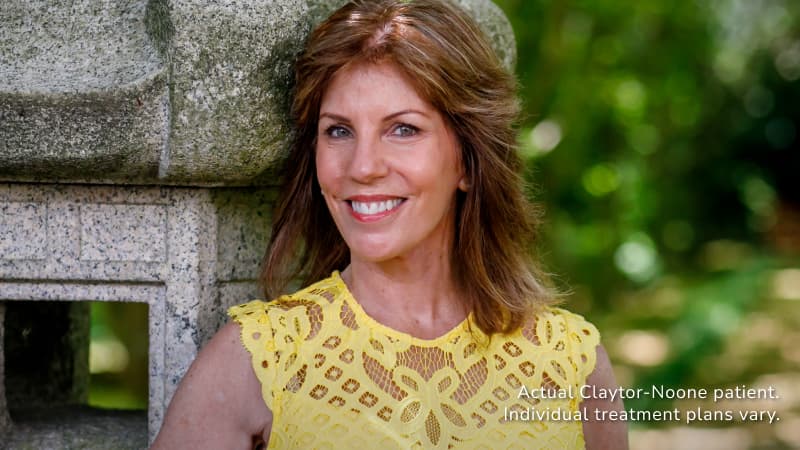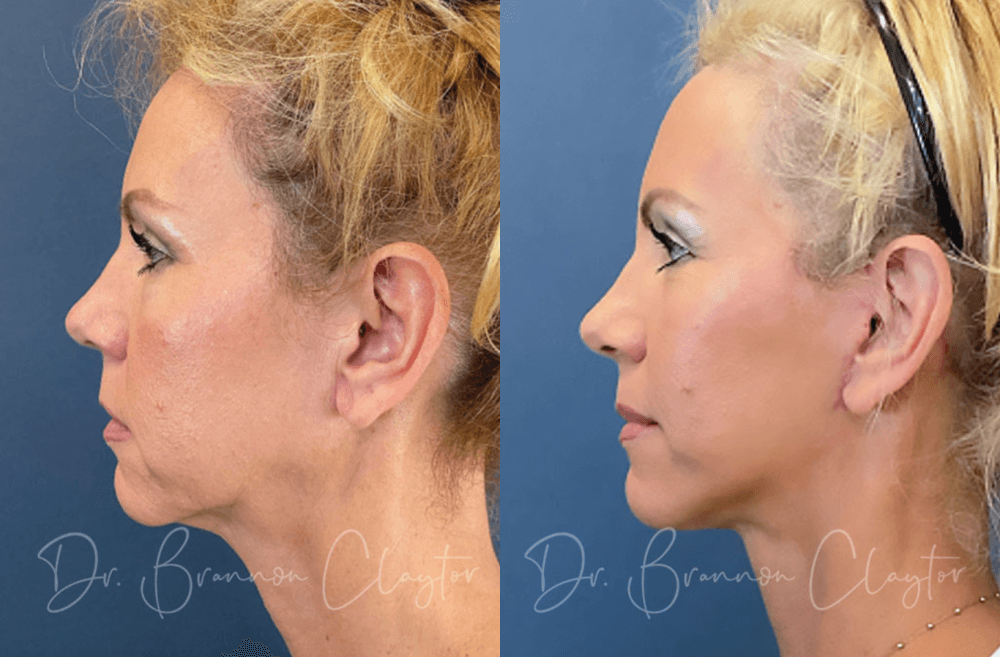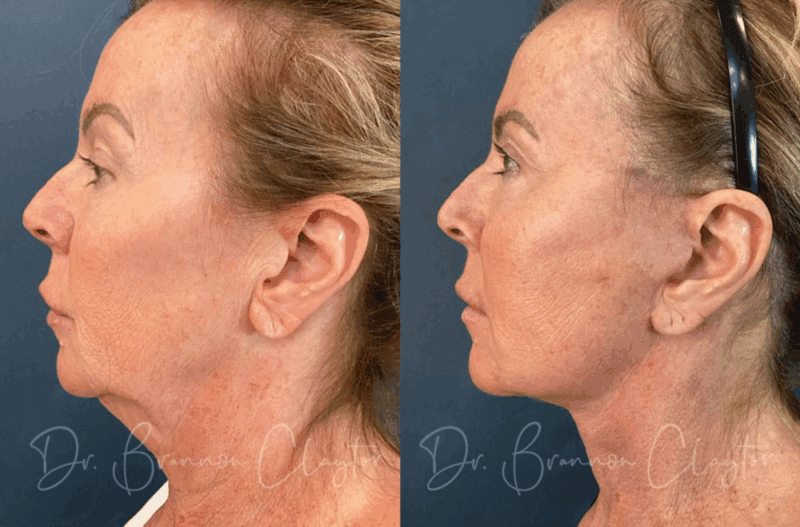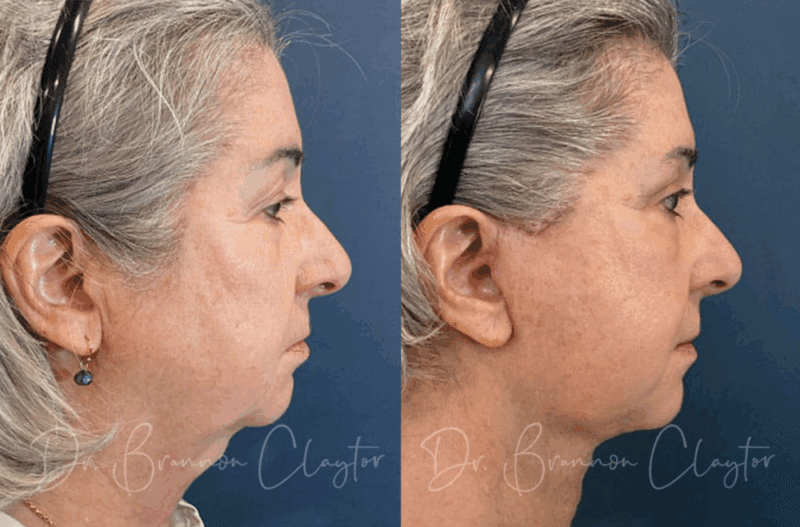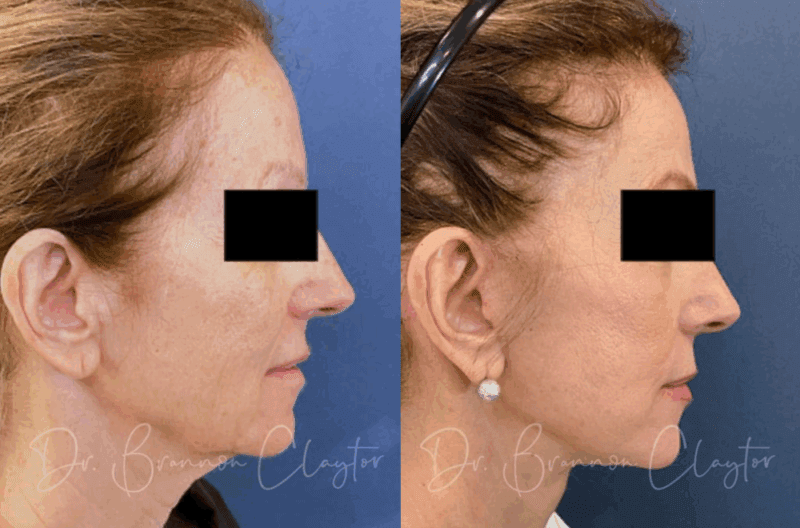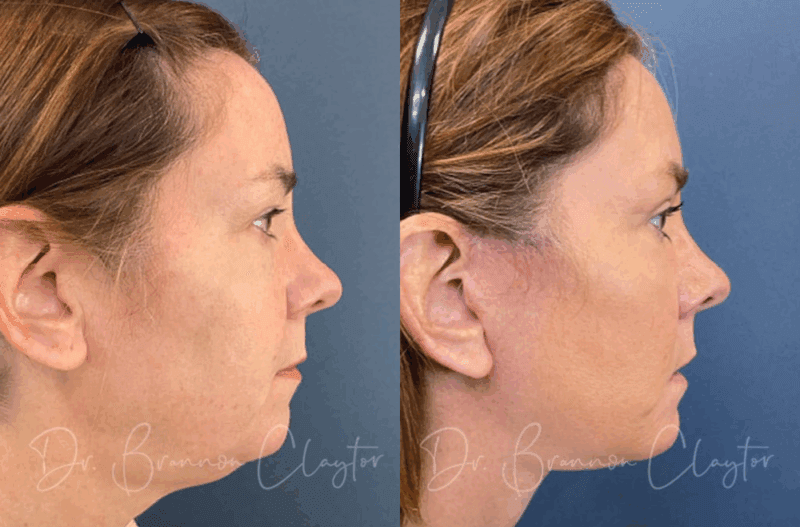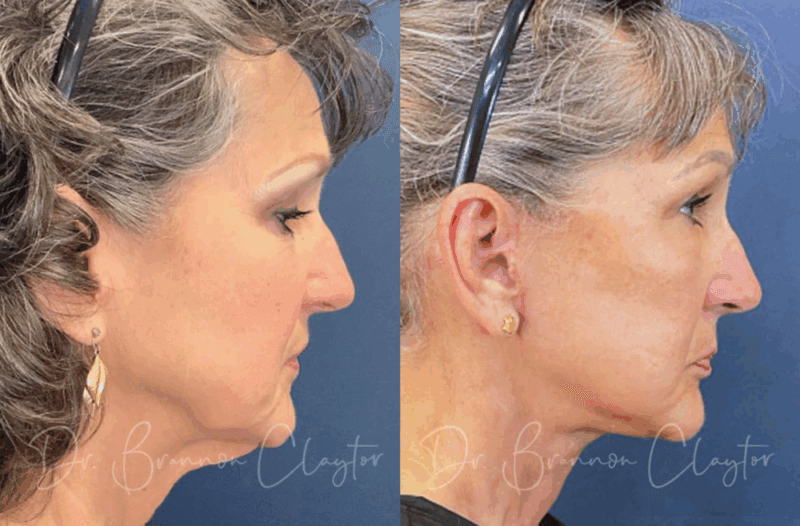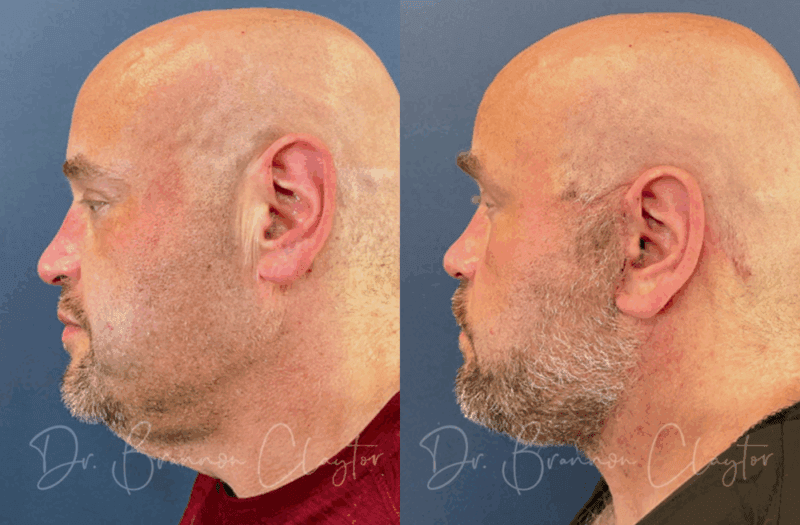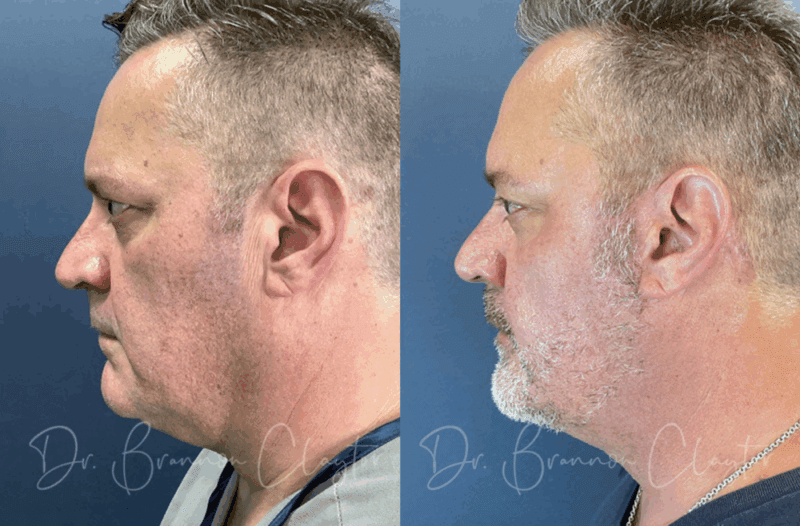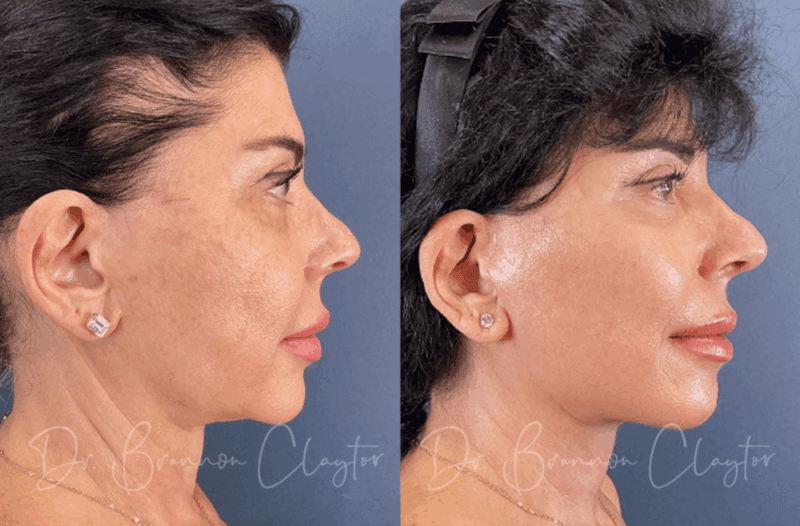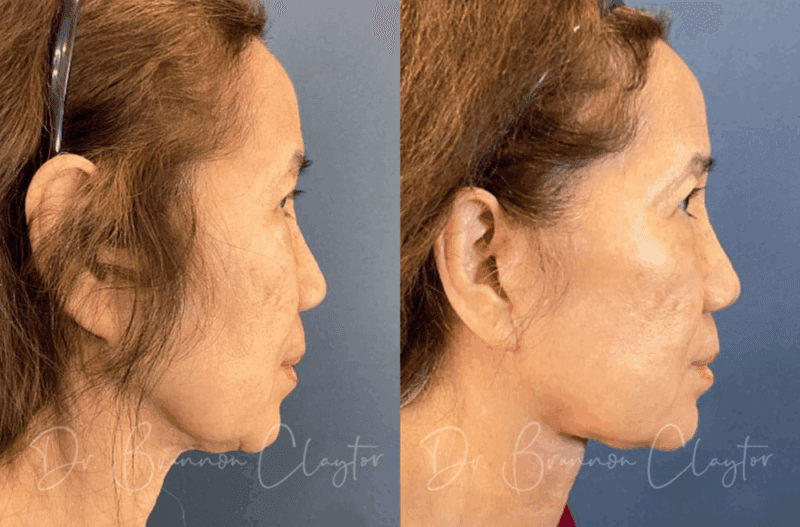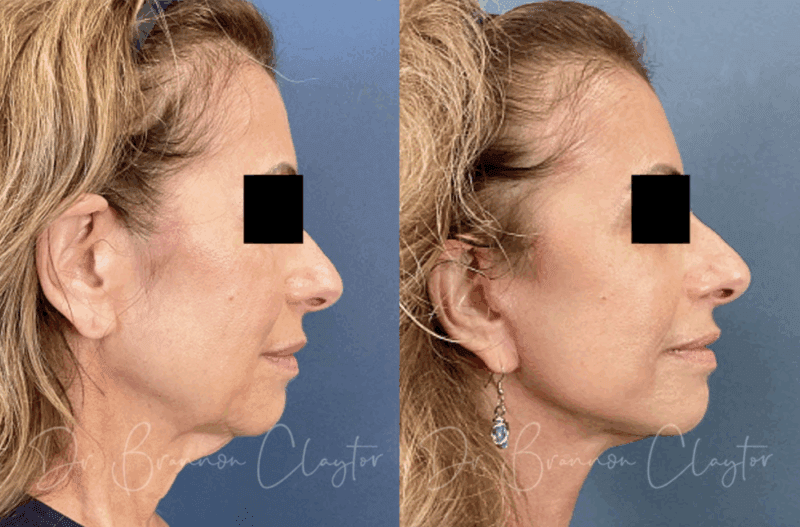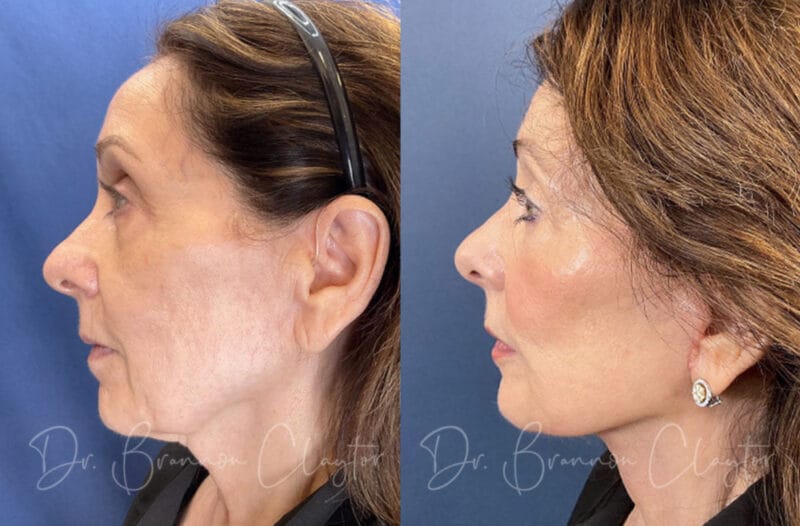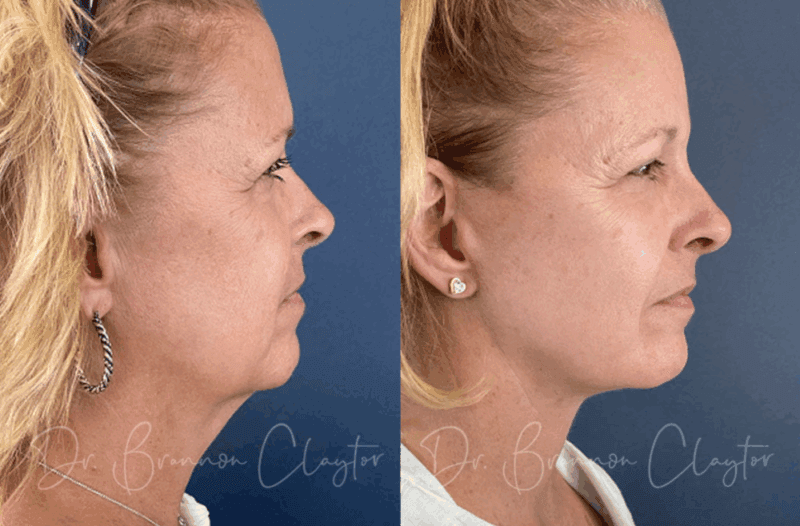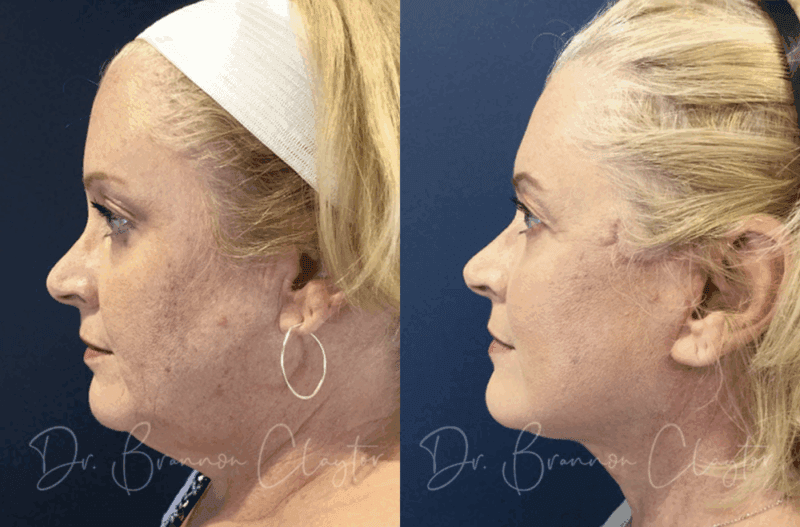Facelift (Rhytidectomy) – Facelift Philadelphia
Facial aging is a natural byproduct of gravity, sun exposure, as well as the loss of fat muscle, and bone. Each individual will require a facelift procedure, or procedures, unique to their particular facial structure and aging frustrations. Philadelphia facelift surgeon Dr. R. Brannon Claytor is nationally recognized as an expert in the deep plane facelift technique, the ideal approach to achieve the longest-lasting, most natural-looking facelift results.
What is facelift surgery?
Facelift surgery is one of the most common plastic surgery procedures available. A facelift removes wrinkles, sagging and skin laxity for a younger, more refreshed appearance for men and women. A facelift procedure reverses the signs of aging by tightening muscles, removing fat, and trimming excess skin, rejuvenating the mid- to lower face, including the cheeks, mouth, chin, and neck. Dr. Claytor employs the most up-to-date techniques to enable patients to achieve the safest, most natural-looking result. His expertise enables him to combine the facelift with an eyelift (blepharoplasty), a lip lift, and/or facial fat grafting to achieve optimal results.
Dr. R. Brannon Claytor
Dr. Claytor is board certified by the American Board of Plastic Surgery and holds over 20 years of experience as a cosmetic plastic surgeon. An innovator and teacher in the field of plastic surgery, he uses advanced techniques like the drain-free tummy tuck and deep plane facelift to streamline recovery and provide natural-looking, durable results.
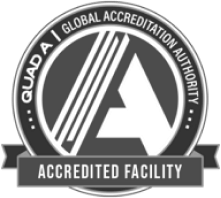
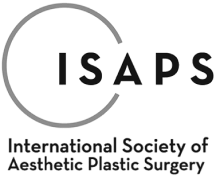
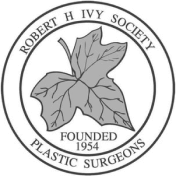
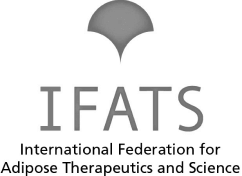
Facelifts for Women
For women, a facelift is designed to restore youthful facial contours while maintaining your natural beauty. Common facial aging concerns like midface sagging, skin laxity, and jowls are addressed through advanced techniques such as the deep plane facelift, mini facelift, and facial rejuvenation procedures.
Dr. Claytor customizes every approach based on your anatomy and goals. He also specializes in neck lifts, non-surgical facelift options, and facial cosmetic enhancements to help women look refreshed, and never overdone.
Facelifts for Men
Facelifts for men are rising in popularity as more patients seek to maintain a youthful, defined look without compromising masculine features. A male facelift in Philadelphia targets common concerns like sagging skin, jowls, and deep folds, especially around the lower face and jawline.
Dr. Claytor offers tailored solutions for men seeking facial rejuvenation in Philadelphia, including the deep plane facelift, neck lift, brow lift, and mini facelift, with a focus on natural facelift results and facial contour improvement. Whether surgical or non-surgical facelift options, we help men restore confidence with discreet, effective outcomes.
What type of facelift procedure is right for me?
Understanding facelift techniques
There are several different techniques for facial rejuvenation; however, as one of the best facelift surgeons in Philadelphia, Dr. Claytor prefers the deep place facelift technique over other techniques such as a mini facelift, short scar facelift, full facelift, or SMAS facelift. Dr. Claytor tailors your surgical plan to your unique needs and goals. He will first evaluate your skin texture and elasticity, underlying facial bone structure, neck, and jawbones. Then, he will explain how he will use the deep plan technique to fully personalize your facelift procedure and what you can expect as a result
“Dr. Claytor and his staff were excellent. Words cannot express the comfort I felt from everyone in his office, not to mention that Dr. Claytor called me personally before, during and after my procedure to see how I was doing and if I needed anything. Thank you Dr. Claytor, Emily, Debbie and the rest of the staff for such a professional and comforting experience.”
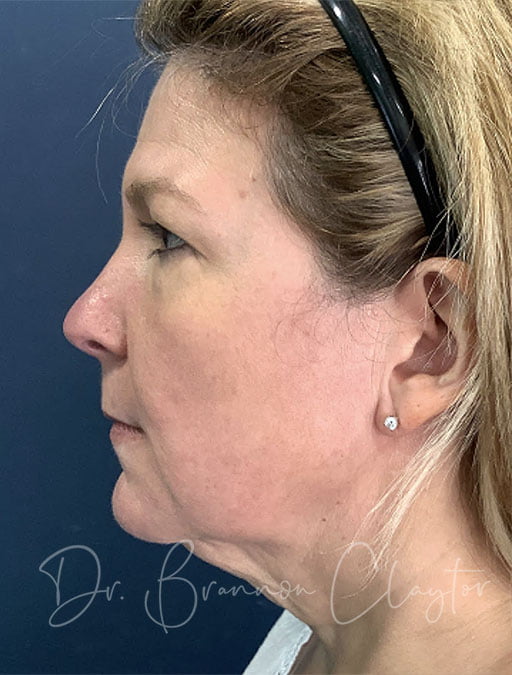
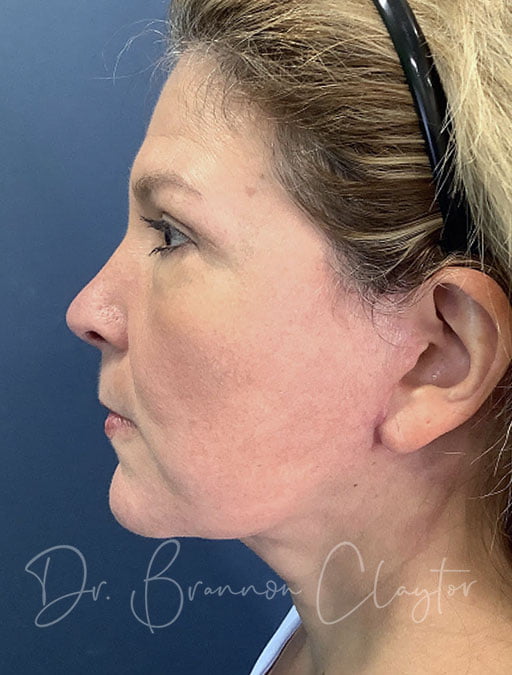
*Individual results may vary.
What is a deep plane facelift?
Unlike traditional facelifts that are performed using the SMAS (superficial muscular aponeurotic system) method, deep plane facelifts allow Dr. Claytor to treat the skin as well as underlying muscles and tissue. Shaping deeper facial tissues as part of your facelift can help you avoid the windswept look that can occur if sagging surface skin alone is overly tightened.
The deep plane facelift technique relies on small incisions within the hairline (along the sideburns), which allow access to the deeper facial ligaments tethering the SMAS to the underlying tissue. This requires extensive knowledge of facial nerves, which are quite delicate and run very close to the retaining ligaments; thus Dr. Claytor will immediately identify the patient’s facial nerve pathways and maintain their integrity throughout the process.
Continuing the deep plane facelift process, Dr. Claytor will manipulate the SMAS and skin as a unit, lifting, tightening, and anchoring the temporal fascia (deep connective tissues) higher up on the mid-face. Once facial tissues are in a lifted position, excess skin may be excised to create a more defined jawline and profile. Excess fat removal is also a part of a deep plane facelift, and in many cases, fat pads can be redistributed to achieve a youthful, volumized appearance. As tension is not placed singularly on the skin, with a deep plane facelift Dr. Claytor is able to create exceptionally natural-looking, long-lasting facial rejuvenation results.
Facelift Trends: Deep plane facelift = vertical facelift
You may have heard of the facelift trends “vertical” face and neck lift, but did you know that this is the same as Dr. Claytor’s deep plane facelift? Deep plane facelifts release the retaining ligaments to vertically lift the SMAS and skin as one, creating a more natural, longer-lasting facelift. And, they may be combined with other procedures for comprehensive results.
Learn more: How Dr. Claytor performs a vertical facelift Philadelphia »
“Highly recommend Dr Claytor! He is brilliant and the most personable and caring surgeon I have ever met! I met with 4 doctors before going to him and my search ended as soon as I consulted with him. His expertise with deep plane facelifts is well known and I knew that was what I wanted. My results are fabulous…I’m told I look 10-15 yrs younger! I’m only 2 months PO and have been going out in public since day 10! My scars are hard to see and are healing so well. I teach fitness classes 3-4 days a week and was back at the gym 1 month PO. I am having a bit of a tough recovery (I always do with surgery). Dr Claytor and his team have been by my side the entire time! They are easily reached and truly care about my issues. Thank you so much Dr. Claytor, Debbie, Emily, Julie, Dani and Sarah!”
See a 360° view of this patient’s stunning deep plane facelift results in the video below:
What signs of facial aging do facelifts treat?
Deep plane facelifts are most effective for patients who are seeking treatment to the following areas of their face:
- Midface sagging
- Wrinkles and lines of the face
- Deep creases under the eyes
- Deep creases between the nose and mouth (nasolabial folds)
- Jowls due to loss of muscle tone
- Sagging areas of skin or fat
- Loose skin and fat under the chin and neck
The signs of aging can be reduced by a face-lift as it removes excess fat, tightens the underlying muscles, and redrapes the skin around the neck and face.
This patient had a facelift to boost their confidence and reduce signs of facial aging, like lines and wrinkles. Give their story a listen!
“I would do it over again in a heartbeat”
In this story, our lovely patient is 1 year past her facelift procedure and she couldn’t be happier with the results. Before her face was sagging and aged, but since the surgery she has felt younger and much better about herself. She is especially pleased with how natural it looks, remarking that she looks more youthful without any obvious signs of surgery.
Listen to more facelift patent stories »
This 71-year-old patient desired facial rejuvenation. After photos show 6 weeks post-op deep plane facelift performed under tumescent anesthesia.
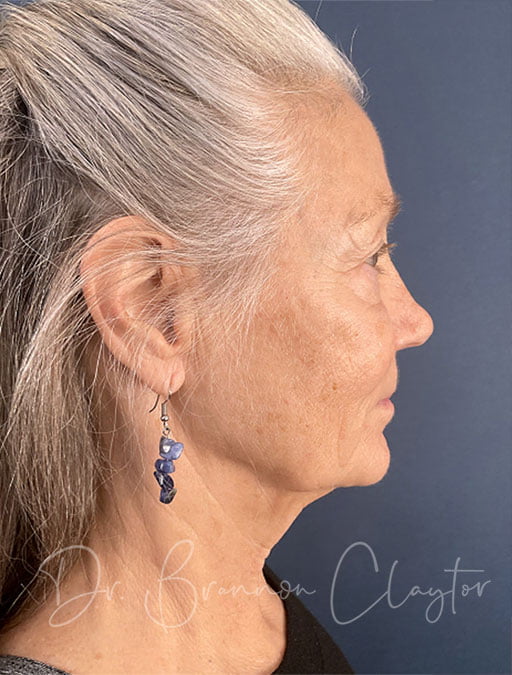
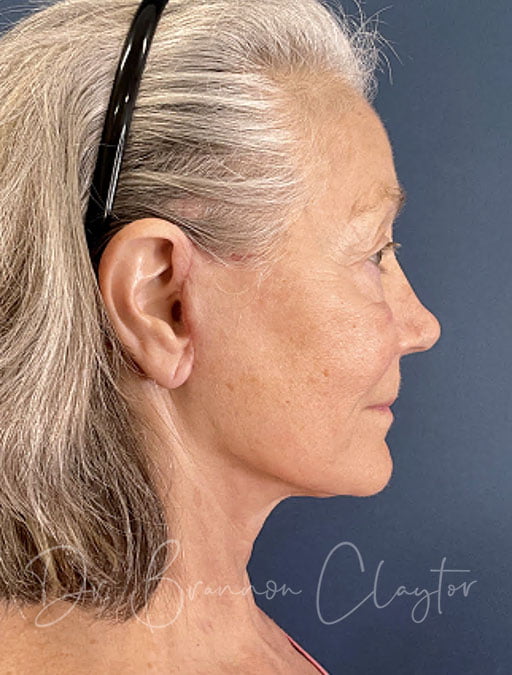
*Individual results may vary on a case-by-case basis
Good candidates for a facelift in Philadelphia
The ideal candidates for a facelift in Philadelphia are those who are generally healthy, do not smoke, and who are experiencing any of the following effects of aging:
- Jowls, droopy cheeks, or loose skin and fat under the chin
- Loose skin and fat around the neck, colloquially known as “turkey neck”
- Diminished facial volume, including hollow tear troughs and/or sunken cheeks
Both male and female candidates benefit from addressing the surface skin and the underlying facial musculature with a deep plane facelift, to provide more youthful structure and longer-lasting results. The goal for every procedure performed by double-board certified plastic surgeon Dr. R. Brannon Claytor is to enhance the patient’s natural appearance, helping them to feel their youthful best.
It is also important to note that age is not simply just a number. Philadelphia facelift surgeon Dr. Claytor looks beyond numeric age and assesses the patient’s health and activity level. There are plenty of 90-year-olds who still jog every day or volunteer and live a vibrant, active life. Those patients who are healthy and wish to rejuvenate their appearance are candidates for a facelift. Many choose to have their procedures performed under local anesthesia. They appreciate the ease of the treatment, and with Dr. Claytor’s careful monitoring of their post-op care, they respond as well as younger patients.
What to expect from your facelift procedure
Facelifts are typically outpatient procedures and may be performed in an office-based facility, surgery center, or hospital. Patients may have a choice of IV sedation or general anesthesia which allows the patient to be asleep and feel no pain during the duration of the procedure. (Most (90%) of Dr. Claytor’s patients undergo the facelift procedure under tumescent anesthesia.) The way a deep plane facelift is performed varies depending on the patient’s anatomic changes due to aging. The length of the procedure is determined by the extent of the surgery and if the patient opts to combine their facelift with another procedure.
During facelift surgery, an incision is made around the ear, sometimes extending into the scalp. From here, Dr. Claytor makes precise adjustments specific to each patient’s facial structure and goals. Most include sculpting, lifting, and repositioning the underlying fat, muscle, and tissues, while also trimming and reshaping the skin for dramatic yet natural-looking results.
In this video, Dr. Claytor extensively discusses the deep plane facelift incisions, technique, and results:
Video transcript
“Dr. Claytor here sharing with you what is a deep plane facelift, and how does it generate that kind of improvement? So here we have our lovely patient her before and her after. And so her biggest frustration is her neck and her jowls that have come down. What she’s looking for is a more youthful return to her previous self, and that’s really what we’re after. We’re not about changing people and making them look different. We want them to be the best version of themselves.
What happens when we age is we get facial descent our malar eminence. Our bone here, it involutes and everything drops down. What we start to see is downward descent of our face and that is exhibited not only in jowling down here, but also in excess neck and fat skin down here. It’s very very frustrating and patients come in frequently saying, “Listen this is not who I am. I look in the mirror and I don’t see myself.” And actually, in the flex view, it’s even worse. So the goal of this operation is to rejuvenate the patient’s aging elements, to go into the face and lift back vertically what had been falling down inferiorly. The way we do this is with very small little incisions that are hidden along the ear, what we call the hairline and the sideburn region. And then these come back and they’re hidden back behind the ear and then they come down along the hairline there so that they’re very well disguised. Not infrequently I will also go up into here which gives me access to be lifting in that orientation with this SMAS that is going to be lifted.
That takes us to what is the difference between a SMAS plication and a deep plane facelift. That question comes up every single time a patient comes in for a consultation. And so it’s a great question and so we’re going to answer it here. So here we have our platysma muscle in our neck it really has no function other than being a muscle of animation. You move it around and you can see your neck muscles move. It has nothing to do with actually moving your head. Right along here is our mandible and the mandible comes down along here. And so below the mandible is where you have your platysma muscle. Above the mandible is where you have your SMAS muscle which stands for sub-muscular aponeurotic system. So you go from skin to SMAS down to the muscle and then you go down deeper to the bone. So when people have a SMAS plication what’s happening is the SMAS aspect of it is lifted and plicated up here and it’s for a very very superficial lift that goes on generally about as such. And so you’re really only getting about that much lift. Some people will go down here with it and allow the whole area to lift up but that’s what a SMAS plication is. In the deep plane lift what we’re doing is we are going underneath that SMAS so this SMAS is continuing up here and so you’re making the incisions that we’ve marked here and we’re lifting up that tissue and we’re moving in underneath the skin layer and then we’re coming up to this SMAS.
What we do in the deep plane lift so this is the deep plane is that we make the incision pretty much from the lateral aspect of the eye down to the corner of the jaw sort of in this orientation. That’s where we make the incision down into this SMAS to go up underneath it so that’s what’s the deep plane aspect of it. And while we’re there we come across these retaining ligaments. These are very very stout ligaments that sit here and here and here, and they’re what keep the face soft tissue from being advanced superiorly. They’re sort of, if you will, giant stakes in the ground that are preventing anything from moving around. And so we need to go in and first in the deep plane dissection dissect into the spaces in between these retaining ligaments. So we dissect down into here, we dissect down into here, and we dissect down into here so those tongues, if you will, are opened up. And then we can very clearly see around what’s going on, and we come across the retaining ligaments as we try to connect these two. What makes this operation so challenging are the facial nerves that are traveling in this area. They are very delicate, they’re very small, and they need to be treated with tremendous caution. Interestingly the nerves run very close to the retaining ligaments, so as you’re releasing the retaining ligaments you need to be looking for the very delicate facial nerves. The facial nerves come out from underneath the ear into a pattern that’s somewhat like this. So you can see that the deep plane facelift basically goes right along where the facial nerves are moving from behind the ear out into innervating the facial musculature and again this is what makes this operation so incredibly technically challenging. But if you can understand these different tongues that are advanced into the tongues that are advanced in between the retaining ligaments and then, therefore, allow connection between these two to further release and identify and remove these retaining ligaments to release them. Once these retaining ligaments are released now this entire area is very mobile and can be repositioned, and so if you look at people on a three-quarter view (this is that three-quarter view), patients who have a very high cheek area have a very youthful and aesthetic appearance when we age that cheek area drops down. That three-quarter view you see that area drop down and then it bunches up down here in the jowls which is really what gives you that aged appearance so by mobilizing this SMAS after you’ve released the retaining ligaments now with sutures. Remember I said that this area gets lifted so imagine that this entire area is now lifted up this way now sutures can be attached once these areas are connected and the retaining ligaments have been released and you very delicately worked around the facial nerves and left them intact now the sutures can be secured here and up here and that’s what takes this tissue and elevates it superiorly. That’s what creates the tremendous power and effect of the deep plane facelift.
If we move over to our after patient why does she look different? She looks different because all of these tissues have been moved up and we’ve been able to reposition her malar eminence back in a more youthful position. That’s part of it. The other part of it is down in the neck. How do we create this beautiful jawline? Well the way you do that is by coming down along the mandible here and releasing that platysma muscle, again, needing to be very careful of the facial nerves, but these are similarly just like these tongues into and underneath this SMA. This is released along here generally almost to about the corner of the mouth or what we call the marionette line. And so the release of the platysma is all the way along to there and by releasing that now you’re able to take this platysma muscle, which is part of the hanging sagging skin of the neck, and lift it and reorient it. In addition all the fat that’s in here is removed. All that excess fat we take out now once that’s released the muscle is then elevated and secured back here back into the mastoid fascia and that’s what creates that incredibly powerful strong neckline and jawline. There’s the mandible. Now that muscle which used to go this way, now the muscle comes up here and it’s very nicely secured back to the mastoid fascia here. With the platysma muscle section underneath the jawline that creates this gorgeous sharp neckline an incredibly well-defined jawline in combination with this mass now being elevated up superiorly and secured in this orientation. It gives you five 10-year lifting result of rejuvenating and refreshing and giving you that youthful appearance. THe big difference again between the SMAS plication and the deep plane face lift is in this SMAS plication. You’re really just reefing up a small portion and you’re not releasing the retaining ligaments as opposed to the deep plane face lift where you’re going in underneath this mass, you’re identifying the facial nerves, you’re identifying the retaining ligaments, and you’re releasing the retaining ligaments. I can’t stress enough really the biggest difference between this SMAS placation and the deep plane facelift is the ability to release those deep retaining ligaments. That’s what gives you that very sustainable and dramatic lift, and addresses the jowl, and addresses the cheek region, and gives you that youthful shape back to your face.
I hope you found this helpful. Looking forward to making more of these videos to help explain some of these complex issues that are becoming more commonplace when patients come in and they’re bringing up topics. The patients are coming in today much more educated, and it’s so fun to be able to share this information in a digestible form so that when you come in you’ve got a framework to ask the questions as you’re looking for your rejuvenation journey. Thanks so much.” – Dr. R. Brannon Clayor
Recovery after facelift surgery
Dr. Claytor uses a tumescent technique for the surgical procedure and meticulous surgical skill to dramatically reduce postoperative swelling, bruising, and pain. Because the SMAS and skin are intact during this procedure, less trauma is experienced, helping you to enjoy a shorter recovery period. Once the surgery is complete, your face will be carefully wrapped in surgical gauze and compression wraps. He will follow up with you in the evening to ensure that your post-operative recovery is going according to plan. A follow-up appointment will be scheduled for the next morning so Dr. Clayor can evaluate your first 12 hours of recovery. In the unlikely event a patient has fluid collection underneath the surgical site, a simple aspiration can address it. (Because surgical drains have the potential to cause complications and discomfort, Dr. Claytor has developed highly-regarded surgical techniques to avoid using drains in facelift recovery for the last decade.)
During your follow-up appointment, your dressings will be changed and Dr. Claytor will provide wound care instructions to you and your accompanying caregiver. Continuous wear of dressings and compression wraps will minimize bruising after surgery. After one week, patients will return for a follow-up visit so Dr. Claytor can monitor the healing process and remove your sutures. A final follow-up appointment takes place between four to eight weeks; Dr. Claytor also enjoys seeing patients in the months following, when final results are achieved.
What is the typical recovery time after a facelift in Philadelphia?
Recovery time for a facelift in Philadelphia typically ranges from 10 to 14 days for most daily activities, though full healing and facial contour refinement can take several weeks. Downtime depends on the technique used — mini facelifts heal faster, while deep plane lifts may take slightly longer.
How can I support a smooth facelift recovery?
For optimal facelift recovery, follow your surgeon’s instructions: rest with your head elevated, avoid strenuous activity, stay hydrated, and attend all post-op visits. These steps help reduce swelling and support natural healing, especially after more advanced procedures like a deep plane or full facelift. If you have any concerns after your facelift surgery, Dr. Claytor is always just a call away, and is here for peace of mind to support you during this time.
“I was given Dr Claytor’s name by my dermatologist, who didn’t know him but had seen his work on the faces of some of her patients and was impressed by the natural looking results. She was right, no one who didn’t know I had the procedure could tell, and I was out in public just one week afterwards. Everyone says, you look really good, did you lose weight, or change your hair?…Every friend who now knows has asked me to text them his info…”
Results of a facelift in Philadelphia*
With good maintenance, your deep plane facelift results will last between 10-15 years (traditional facelifts typically only last about 8-10 years before results start to weaken). While signs of aging will be significantly improved, skin continues to age, so it is important to have a regular skin care regimen to maintain your results. Included in your facelift is a consultation with our medical esthetician who will provide you with a pre-surgery ZO™ skincare regimen that will help prepare your skin for the best possible results. We carry only medical grade skincare products that will enable you to enjoy your investment in yourself for many years.This is especially important for the incisions placed in the hairline or near the ear. and as time goes on the scar will begin to fade but Dr. Claytor recommends continued use of scar cream and sunscreen to minimize scarring.
*Individual results may vary.
Listen to Stories From Dr. Claytor’s Facelift Patients
In the following audio stories, Dr. Brannon Claytor engages in conversations with his facelift patients, delving into the genuine experience during their plastic surgery journeys. From their experiences with anesthesia to the remarkable results, these stories offer insights into what it truly feels like to navigate the weeks, months, or even years after a facelift procedure.
Watch Our Real Facelift Patient Debbie After her Facial Enhancement and Tummy Tuck
Video Transcript
I feel amazing. I feel vibrant. I know I don’t look my age because I don’t want to look my age. When you’re up there and you know that you have the confidence about yourself because of the procedure that you’ve just gone through, you know you look amazing and you’re happy that that has come through, that you’ve achieved what it was you wanted to achieve.
Debbie is about to turn 64, and she had a revision neck lift and she also had a tummy tuck. She looks phenomenal. She just is a really wonderful person, and she too wanted to look the way she felt, and I think she really does. She’s here and she’s going to be in a grocery store shot as she is in a carnival costume. Oh, there she is, looking amazing at the grocery store.
How much does a facelift cost in Philadelphia?
The cost of a facelift in Philadelphia varies based on the technique used, the extent of the procedure, and whether the procedure includes a neck lift or other facial cosmetic procedures. We will provide you with an exact quote during your facelift consultation with Dr. Claytor.
Understanding facelift costs
The complete cost for a surgical procedure will include the surgeon’s fee, the hospital or surgery center fee, and the anesthesia fee. There are several options within the facelift that will dictate whether Dr. Claytor will perform your surgery in our Quad-A accredited surgery facility or at the hospital. Those options and decisions will be discussed at your consultation.
“I can’t say enough good things about Dr. Claytor and his staff. Dr. Claytor has all of the things you’d want your surgeon to have, such as depth of knowledge in his field, extensive experience, professionalism, bedside manner, but he also has a kindness and warmth that is not present in all physicians. I always felt that I was in good hands…”
- Key Benefits
- Glossary
Facelift Benefits
- Improved Facial Contours: The deep plane facelift effectively lifts and repositions the deep structural layers of facial tissues, including ligaments. This technique keeps superficial skin and muscles intact and allows for a more comprehensive rejuvenation of the face, addressing deep-seated sagging and laxity.
- Reduced Wrinkles and Fine Lines: It diminishes the appearance of wrinkles and fine lines for a rejuvenated and refreshed look
- Long-Lasting Results: The deep plane facelift is known for providing highly durable results that are longer-lasting than those of a traditional facelift. By repositioning the supporting ligament of your underlying musculature, a deep plane lift helps to maintain the improvements achieved during the surgery for as long as 10-15 years.
- Comprehensive rejuvenation for the face and neck: Dr. Claytor most often performs the deep plane facelift (which primarily affects the midface and jowls) with an open platysmaplasty, which is an advanced neck lift method. This procedure plan can impact the face, cheeks, jawline, and neck to create a harmonious (and more natural looking) appearance.
- Natural-Looking Results: By repositioning the underlying facial structures, a deep plane facelift can restore youthful contours without creating an overly tightened, windswept look.
Rhytidectomy: Rhytidectomy, also known as a facelift, is a surgical procedure designed to reduce or eliminate visible signs of aging in the face and neck by tightening skin and underlying tissues.
SMAS (Superficial Musculoaponeurotic System): The SMAS is a layer of muscles and connective tissue that lies beneath the facial skin. The SMAS is often tightened during a deep plane facelift to provide a lifted appearance.
Platysma: The muscle in the neck that is sometimes tightened during a facelift.
Submentoplasty: A procedure that addresses issues in the neck and under the chin, often performed in conjunction with a facelift.
Incision Sites: Locations where surgical cuts are made, which can vary depending on the type of facelift.
Endoscopic Facelift: A less invasive facelift procedure using small incisions and specialized equipment.
Non-Surgical Facelift: Procedures that aim to provide facelift-like results without surgery, often using injectables, lasers, or suture suspension technology.
Mini Facelift: A less extensive facelift that focuses on specific areas of the face.
Full Facelift, Face lift, or Facelifts: A more comprehensive, traditional facelift procedure that addresses multiple areas of the lower face and usually the neck (not the upper face).
Mid Facelift: A facelift targeting the middle third of the face.
Thread Lift: A non-surgical procedure using threads to lift and tighten the skin and promote collagen production.
Blepharoplasty: Eyelid surgery that may be performed in conjunction with a facelift.
Rhytids: Medical term for wrinkles.
Skin Resurfacing: Procedures to improve the texture, clarity, and overall appearance of the skin, sometimes performed alongside a facelift.
Fat Transfer (Fat Grafting): The process of moving fat from one area of the body to the face to improve volume and contours.
Jowls: Sagging skin on the lower part of the face, often addressed during a facelift.
Facial Implants: Surgically placed devices used to enhance facial contours.
Recovery Time: The period it takes for a patient to heal post-surgery.
Scarring: The formation of fibrous tissue as the skin heals from surgical incisions.
Anesthesia: Medications used to numb or sedate patients during surgery.
Brow lift, browlift, or browpexy: A surgical procedure to raise and reshape sagging brows for a more youthful appearance.
Ponytail Facelift: A minimally invasive facelift technique that tightens the face through small incisions, often behind the ears, simulating the look of a pulled-back ponytail, popularized through social media.
Deep Plane Facelift: An advanced facelift method targeting deeper facial structures, such as ligaments, for more comprehensive and natural-looking rejuvenation.
Neck lift: A cosmetic surgery to improve the appearance of the neck by tightening the skin and underlying muscles and removing excess fat. Addresses a “turkey neck” or “double chin” by tightening tissues and restoring an oval face shape and elegant, well-defined jawline.
Facial: A skin treatment that cleanses pores, exfoliates dead skin cells, and treats common skin concerns for a healthier complexion. Options at our medspa include Hydrafacial, chemical peels, and laser treatments.
Wrinkles: Lines and creases in the skin, often resulting from aging, sun damage, and facial expressions.
Fine lines: Subtle creases in the skin, typically the first signs of aging and skin damage.
Scars: Marks left on the skin after a wound or injury has healed, varying in size and texture. Surgical scars are minimized using refined techniques and post-op protection, though laser, microneedling, or combined therapies can reduce them further as needed.
Surgery: Medical procedures involving incisions or manipulations of the body to diagnose, treat, or improve physical function or appearance.
Treatments: Various medical or cosmetic procedures used to address specific health or aesthetic issues.
Laser: A technology in medical and cosmetic procedures that uses focused light for treatments like hair removal, skin resurfacing, and vision correction.
Concerns: Specific issues or conditions that patients wish to address, ranging from medical symptoms to aesthetic preferences. Browse Dr. Claytor’s list cosmetic concerns and treatments, from drooping neck to dull skin, here.
Laser Skin Resurfacing: A cosmetic procedure using laser technology to improve skin texture, tone, and appearance by removing layers of skin.
Surgical, Surgeon: Relating to surgery, a surgeon is a medical professional who performs operative procedures. Dr. Claytor is board-certified by the American Board of Plastic Surgery, a credential that represents his training and safety in the specialty, specifically.
Patients: Individuals who receive medical care or treatment from a healthcare professional.
Loose Skin: Skin that has lost its firmness and elasticity, often due to aging, weight loss, or other factors.
Aging: The process of becoming older, often marked by physical, cosmetic, or functional changes in the body.
Candidate: A person considered suitable for a particular medical procedure based on their health, condition, and desired outcomes.
Cosmetic Surgeon: A medical specialist who performs surgeries primarily to enhance appearance and aesthetic appeal.
Facial Plastic Surgery: Surgical procedures focusing on the head, neck, and face to improve appearance and functionality.
Rhinoplasty: A surgical procedure to change the shape or improve the function of the nose.
Consultation: A professional meeting with a healthcare provider to discuss and plan a medical or cosmetic procedure.
Incisions: Surgical cuts made for surgery; incisions near the ears and ear area are commonly used in facelifts and other facial surgeries to minimize visible scarring.
General Anesthesia: A medically induced state of unconsciousness and lack of sensation used during surgeries to prevent pain and discomfort.
Nasolabial Folds: Nasolabial folds are the deep wrinkles or lines that extend from the sides of the nose down to the corners of the mouth, which often become more pronounced with age.
Excess Skin: The extra, sagging skin that often results from aging, significant weight loss, or other factors, sometimes necessitating surgical removal to improve appearances.
Lip Lift: A lip lift is a surgical procedure designed to shorten the space between the upper lip and the base of the nose, thereby enhancing the prominence and shape of the lips.
Connective Tissue: Biological tissue that provides support, binds together, and protects the various tissues and organs of the body, including skin and muscles.
Twilight Anesthesia: A sedation technique where patients are put into a drowsy, relaxed state but not entirely unconscious, often used for minor or shorter surgical procedures performed in the office setting.
Platysmaplasty: Surgical procedure or technique that tightens and repairs the platysma muscle in the neck, often performed to reduce sagging and create a more youthful jawline and neck.
Composite Facelift: A comprehensive facelift procedure that not only addresses the SMAS but also lifts and repositions the skin and muscles of the mid-face, lower eyelids, and neck.
Minimally Invasive Facelift: A facelift technique that requires smaller incisions and less tissue manipulation, resulting in quicker recovery but offering more subtle results compared to a deep plane facelift.
Ptosis: A medical term describing the drooping or falling of a body part, often referring to sagging facial features that a facelift aims to correct.
Edema: Medical term for swelling, a common temporary side effect following surgical procedures.
Seroma: Accumulation of clear bodily fluids at the surgical site, which may need to be drained.
Hematoma: A collection of blood outside of blood vessels that may occur at the surgical site, sometimes requiring intervention.
Drainage: The removal of excess fluids, often through tubes, from the body post-operatively to aid in the healing process.
Facial Analysis: A systematic evaluation process used by surgeons to assess a patient’s facial anatomy, skin quality, and aging signs to recommend appropriate surgical or non-surgical interventions.
Candidacy: Evaluation of a patient’s overall health, medical history, and specific facial aging characteristics to determine their suitability for a deep plane facelift.
Collagen: A protein found in the skin and connective tissues, essential for maintaining skin strength and elasticity.
Elastin: A protein that allows the skin to resume its shape after stretching or contracting, helping it remain firm and tight.
Facial Fat Pads: Pockets of fat located in the face that provide volume and contour; these may shift or diminish with age, affecting the face’s overall appearance.
Neck Lift (platysmaplasty): A surgical procedure designed to improve visible signs of aging in the neck and jawline, often combined with facelifts for a more harmonious rejuvenation.
Contraindication: Conditions or factors that suggest a particular treatment or procedure may be harmful, thus should be avoided. For facelifts, contraindications may include certain medical conditions, lifestyle habits, or medications.
FAQs about facelifts
Dr. Claytor is double board certified in plastic surgery. As one of the few plastic surgeons in the Philadelphia area skilled enough to perform facelift surgery under local anesthesia without the need for post-operative drains, his skill and experience as a Philadelphia facelift surgeon in provide patients with a naturally rejuvenated look. Because each patient’s needs are unique, Dr. Claytor will meet with you during your consultation to evaluate and create a custom facelift surgery plan to help you achieve your aesthetic goals.
Why choose Dr. Claytor for your plastic surgeon?
Double Board-Certified for a high level of safety and precision
Chief of Plastic Surgery at Main Line Health, a top health system
Board Member of The Aesthetic Society, shaping the future of aesthetics
8x Philadelphia Magazine Top Doctor for exceptional patient care
Recognized as one of America’s Best Plastic Surgeons by Newsweek
Drain-free recovery expert for faster, more comfortable healing
Deep plane facelift innovator and global educator
Active researcher in surgical and non-surgical aesthetic advancements
Highly regarded for his surgical expertise and outcomes, as well as his dedicated follow-up care



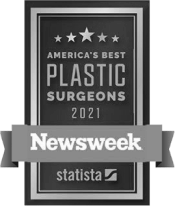

Real patient testimonials about their facelift surgery experience
Here is what a patient had to say about their facelift surgery with Dr. Claytor in a recent RealSelf review:
“Before deciding on Dr. Claytor, I interviewed three other plastic surgeons in the area. I read a lot of articles on deep plane facelift surgery vs. the traditional method. An important consideration was that I did not want general anesthesia. The two traditional facelift surgeons were dismissive of me and made the deep place facelift sound like some crazy fad. In part, their attitude made me choose Dr. Claytor. I am so happy that I did. From the moment you walk in the door, you are treated like a VIP. The staff is welcoming and warm. The consultation with Dr. Claytor is thorough and questions are answered thoroughly. I chose the tumescent anesthesia for my procedure. I did NOT feel any pain. I was relaxed, a little sleepy, and even chatted with the team as they performed the surgery. The first two days, I was in moderate discomfort, but by the third day, I was just taking Extra Strength Tylenol and then in 5 or 6 days the occasional Advil–mostly at night to sleep more comfortably. The follow-ups were great and I am beyond pleased with the way I look. By the second week, something really wonderful happened. I casually looked in the mirror and was…startled for a moment because…there I was. The surgery didn’t make me look like somebody else. It made me look like the me that had been missing for several years. I didn’t feel like the “old person” in the mirror. But people treated that way. Dr. Claytor gave me back my younger face that matched my still youthful self. It has made me feel more confident in my job, how I think of myself and while we’ve all heard at least a few people tell us, “Looks don’t matter..”…HELLO! They do! People who have known me for a long time don’t ask if I’ve had “work done.” They ask me if I had a vacation, tell me I look refreshed, ask me if I am doing something different with my hair and even asked if I’ve lost weight. None of the above. I’ve have been rejuvenated by the Claytor Team. I recommend Dr. Claytor and his staff without reservation.”
Another patient shared this story in a recent Google review:
“I can’t say enough good things about Dr. Claytor and his staff. Dr. Claytor has all of the things you’d want your surgeon to have, such as depth of knowledge in his field, extensive experience, professionalism, bedside manner, but he also has a kindness and warmth that is not present in all physicians. I always felt that I was in good hands. I also must add that Emily, one of the medical assistants in his office, was especially helpful, and was absolutely right on the nose with all of her advice and recommendations (all of the girls were great, I just saw Emily the most). From the reception desk, to appointments, procedures, follow-up, etc, everything from start to finish was 5-star service. The one thing Dr. Claytor does not have, and it’s not his fault, is as many before/after pictures (on the website) compared to other surgeons, which I believe simply has to do with his clients (such as myself) being more private. For me, this wasn’t a problem, but for those that find it to be a deterrent, just know that during your appointment he can show you a lot more pictures to help guide you with your decision making (many clients, like myself, give permission for that, but just not for the website). I will 100% be using Dr. Claytor’s services in the future.”
Read more reviews for Dr. Claytor here.
This 67-year-old patient wished to address loose skin and facial sagging. After Photos show 2 months post-op deep plane face lift.
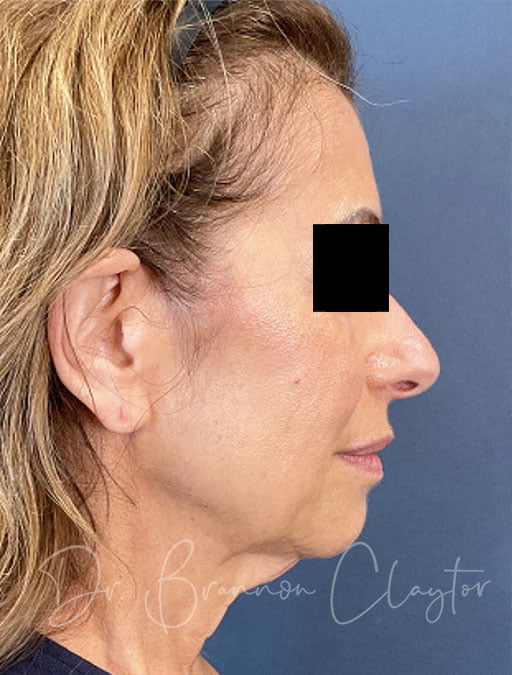
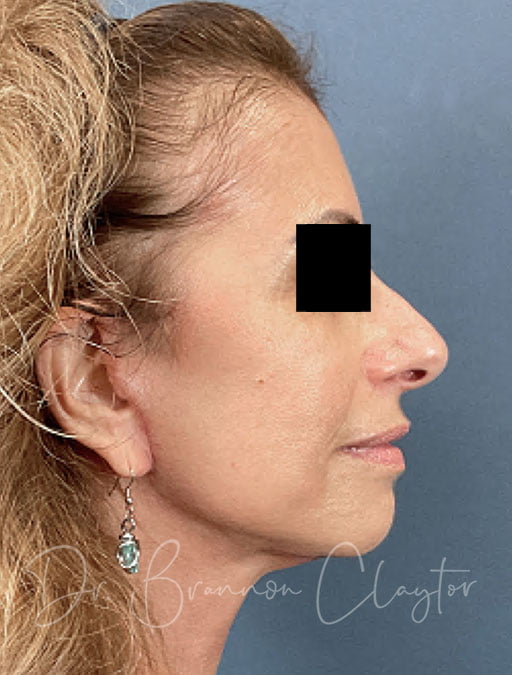
*Individual results may vary on a case-by-case basis
Dr. Claytor performs the facelift procedure at our own Quad-A Certified Surgery Facility as well as at both Bryn Mawr Hospital. Because facelift surgery is performed under local anesthesia in the safety of our certified facility, patients appreciate the ease of their recovery without the grogginess that often results from general anesthesia.
“The whole experience was fantastic! The results exceeded my expectations! I look and feel 10 years younger. Dr. Claytor and his staff made me feel so at ease and comforting. He is an excellent surgeon with a wonderful bedside manner and personality. It is one of the best decisions I ever made. I would highly recommend Dr. Claytor; in fact my neighbor has an appointment with him next month.”
Choose Dr. Claytor, a trusted facelift expert in Phildelphia
Dr. Brannon Claytor has over 20 years of experience as a facelift surgeon in the Philadelphia, Bryn Mawr, and Main Line areas. He recently appeared in Modern Luxury Medicine + Doctors Philadelphia as one of the “city’s finest,” sharing about deep place facelifts as one of his favorite procedures for achieving natural, beautiful results.
Dr. Claytor is a member of The Aesthetic Society, the American Society for Plastic Surgeons, and a Fellow of the American College of Surgeons. Dr. Claytor has won numerous awards for his skill and experience, including “Top Doc” by Philadelphia Magazine, “Top Doctor” by Main Line Today, and one of “America’s Best Plastic Surgeons of 2021” by Newsweek Magazine.
If you’d like to talk one-on-one with Dr. Claytor and learn more about a deep plane facelift, contact our Bryn Mawr plastic surgery office at (610) 527-4833 or schedule a consultation online.
References »
Surek CC, Moorefield A. Deep Plane Anatomy for the Facelift Surgeon: A Comprehensive Three-Dimensional Journey. Facial Plastic Surgery Clinics of North America. 2022 May;30(2):205-214. doi: 10.1016/j.fsc.2022.01.015.
Raggio BS, Patel BC. Deep Plane Facelift. 2023 Apr 3. In: StatPearls [Internet]. Treasure Island (FL): StatPearls Publishing; 2023 Jan–.
Rohrich RJ, Novak M. Male Face-Lift Finesse. Plastic and Reconstructive Surgery. 2023. doi: 10.1097/PRS.0000000000009839.
Quatela V, Montague A, Manning JP, Antunes M. Extended Superficial Musculoaponeurotic System Flap Rhytidectomy. Facial Plastic Surgery Clinics of North America. 2020. doi: 10.1016/j.fsc.2020.03.007.
Rousso DE, Adams AS. Nuances in Superficial Musculoaponeurotic System Rhytidectomy. Facial Plastic Surgery Clinics of North America. 2020. doi: 10.1016/j.fsc.2020.03.010.
Gentile RD. Laser-Assisted Facelifting and Energy-Based Rejuvenation Techniques During Rhytidectomy. Facial Plastic Surgery Clinics of North America. 2020. doi: 10.1016/j.fsc.2020.03.006.
Hammoudeh ZS, Stevens WG. Nonsurgical Adjuncts Following Facelift to Achieve Optimal Aesthetic Outcomes: “Icing on the Cake.” Clinics in Plastic Surgery. 2019. doi: 10.1016/j.cps.2019.06.002.
Jacono AA. A Novel Volumizing Extended Deep-Plane Facelift: Using Composite Flap Shifts to Volumize the Midface and Jawline. Facial Plastic Surgery Clinics of North America. 2020 doi: 10.1016/j.fsc.2020.03.001.
Bater KL, Ishii LE, Papel ID, Kontis TC, Byrne PJ, Boahene KDO, Nellis JC, Ishii M. Association Between Facial Rejuvenation and Observer Ratings of Youth, Attractiveness, Success, and Health. JAMA Facial Plastic Surgery. 2017. doi: 10.1001/jamafacial.2017.0126.
Yang, Huanla. (2023). Research on the Application of Mini Facelift in Facial Plastic Surgery. Dermatological Health. 1. 14-18. 10.26689/dh.v1i2.5363.
Areas Served:

Medically reviewed by Dr. R. Brannon Claytor — Updated on Jul 15, 2025

